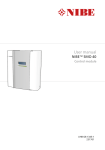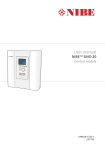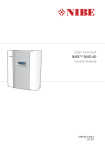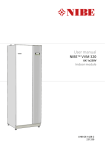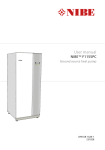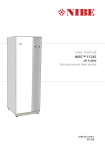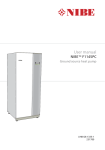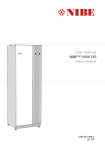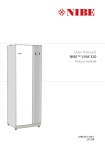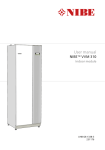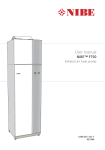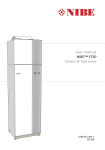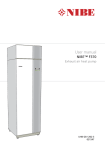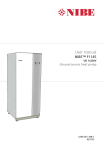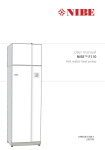Download User manual
Transcript
User manual NIBE™ SMO 20 LEK Control module UHB GB 1436-3 231759 4XLFN JXLGH 1DYLJDWLRQ 2N EXWWRQ FRQILUPVHOHFW %DFN EXWWRQ EDFNXQGRH[LW &RQWURO NQRE PRYHLQFUHDVHUHGXFH A detailed explanation of the button functions can be found on page 10. How to scroll through menus and make different settings is described on page 14. 6HW WKH LQGRRU FOLPDWH WHPSHUDWXUH ,1'225 &/,0$7( +27 :$7(5 ,1)2 ; 0< 6<67(0 The mode for setting the indoor temperature is reached, when in the start mode in the main menu, by pressing the OK button twice. Read more about the settings on page 21. ,QFUHDVH KRW ZDWHU YROXPH ; WHPSRUDU\ OX[ ,1'225 &/,0$7( RII +27 :$7(5 KUV ,1)2 KUV 0< 6<67(0 ; KUV To temporarily increase the amount of hot water (if a hot water heater is installed to your SMO 20), first turn the control knob to mark menu 2 (water droplet) and then press the OK button twice. Read more about the settings on page 36. In event of disturbances in comfort If a disturbance in comfort of any type occurs there are some measures that can be taken before you need to contact your installer. See page 58 for instructions. Table of Contents 1 Important information 2 Installation data Safety information Serial number Contact information SMO 20 – An excellent choice 2 3 6 7 9 2 The control module – the heart of the house Control module's function Contact with SMO 20 Maintenance of SMO 20 3 SMO 20 – at your service 10 10 10 19 21 Set the indoor climate Set the hot water capacity Get information Adjust the heat pump 21 36 40 43 4 Disturbances in comfort 57 Manage alarm Troubleshooting Additional heating only 57 58 61 5 Technical data 6 Glossary 62 63 Index 67 Table of Contents | NIBE™ SMO 20 1 1 Important information Installation data Product SMO 20 Serial number Installation date Installer Type of docking Accumulator/hot water heater Heat pump/output size Add. heat type/power No. Name DeSet fault settings 1.9.1 heating curve (offset/curve slope) 0/9 Serial number must always be given Certification that the installation is carried out according to instructions in NIBE's installer manual and applicable regulations. Date 2 __________________ Chapter 1 | Important information Signed _________________________ NIBE™ SMO 20 Safety information This appliance can be used by children aged from 8 years and above and persons with reduced physical, sensory or mental capabilities or lack of experience and knowledge if they have been given supervision or instruction concerning use of the appliance in a safe way and understand the hazards involved. Children shall not play with the appliance. Cleaning and user maintenance shall not be made by children without supervision. Rights to make any design or technical modifications are reserved. ©NIBE 2014. NOTE SMO 20 must be installed via an isolator switch with a minimum breaking gap of 3 mm. NOTE If the supply cable is damaged, only NIBE, its service representative or similar authorised person may replace it to prevent any danger and damage. Symbols NOTE This symbol indicates danger to machine or person. Caution This symbol indicates important information about what you should observe when maintaining your installation. Chapter 1 | Important information NIBE™ SMO 20 3 TIP This symbol indicates tips on how to facilitate using the product. 4 Chapter 1 | Important information NIBE™ SMO 20 Marking SMO 20 is CE marked and fulfils IP21. The CE marking means that NIBE ensures that the product meets all regulations that are placed on it based on relevant EU directives. The CE mark is obligatory for most products sold in the EU, regardless where they are made. IP21 means that the product can be touched by hand, that objects with a diameter larger than or equivalent to 12.5 mm cannot penetrate and cause damage and that the product is protected against vertically falling drops. Chapter 1 | Important information NIBE™ SMO 20 5 Serial number The serial number can be found on the upper side of the cover on the control module. LEK 6HULDO QXPEHU Caution Always give the product's serial number when reporting a fault. 6 Chapter 1 | Important information NIBE™ SMO 20 Contact information AT KNV Energietechnik GmbH, Gahberggasse 11, 4861 Schörfling Tel: +43 (0)7662 8963-0 Fax: +43 (0)7662 8963-44 E-mail: [email protected] www.knv.at CH NIBE Wärmetechnik AG, Winterthurerstrasse 710, CH-8247 Flurlingen Tel: (52) 647 00 30 Fax: (52) 647 00 31 E-mail: [email protected] www.nibe.ch CZ Druzstevni zavody Drazice s.r.o, Drazice 69, CZ - 294 71 Benatky nad Jizerou Tel: +420 326 373 801 Fax: +420 326 373 803 E-mail: [email protected] www.nibe.cz DE NIBE Systemtechnik GmbH, Am Reiherpfahl 3, 29223 Celle Tel: 05141/7546-0 Fax: 05141/7546-99 E-mail: [email protected] www.nibe.de DK Vølund Varmeteknik A/S, Member of the Nibe Group, Brogårdsvej 7, 6920 Videbæk FI Tel: 97 17 20 33 Fax: 97 17 29 33 E-mail: [email protected] www.volundvt.dk NIBE Energy Systems OY, Juurakkotie 3, 01510 Vantaa Puh: 09-274 697 0 Fax: 09-274 697 40 E-mail: [email protected] www.nibe.fi FR NIBE Energy Systems France Sarl, Zone industrielle RD 28, 01600 Reyrieux Tel : 03 88 06 24 10 Fax : 03 88 06 24 11 E-mail: [email protected] www.nibe.fr GB NIBE Energy Systems Ltd, 3C Broom Business Park, Bridge Way, Chesterfield S41 9QG Tel: 0845 095 1200 Fax: 0845 095 1201 E-mail: [email protected] www.nibe.co.uk NL NIBE Energietechniek B.V., Postbus 634, NL 4900 AP Oosterhout Tel: 0168 477722 Fax: 0168 476998 E-mail: [email protected] www.nibenl.nl NO ABK AS, Brobekkveien 80, 0582 Oslo, Postadresse: Postboks 64 Vollebekk, 0516 Oslo Tel. sentralbord: +47 23 17 05 20 E-mail: [email protected] www.nibeenergysystems.no Chapter 1 | Important information NIBE™ SMO 20 7 PL NIBE-BIAWAR Sp. z o. o. Aleja Jana Pawła II 57, 15-703 BIAŁYSTOK Tel: 085 662 84 90 Fax: 085 662 84 14 E-mail: [email protected] www.biawar.com.pl RU © "EVAN" 17, per. Boynovskiy, Nizhny Novgorod Tel./fax +7 831 419 57 06 E-mail: [email protected] www.nibe-evan.ru SE NIBE AB Sweden, Box 14, Hannabadsvägen 5, SE-285 21 Markaryd Tel: +46-(0)433-73 000 Fax: +46-(0)433-73 190 E-mail: [email protected] www.nibe.se For countries not mention in this list, please contact Nibe Sweden or check www.nibe.eu for more information. 8 Chapter 1 | Important information NIBE™ SMO 20 SMO 20 – An excellent choice SMO 20 is an electric control module, which has been introduced to supply your home with inexpensive and environmentally friendly heating. Heat production is reliable and economical with a NIBE air/water heat pump and accumulator/water heater. An additional heater (for example electric/oil/gas boiler) can engage automatically if something unexpected should occur or as reserve operation. Excellent properties for SMO 20: ႑ Easy to read display The control module has an easy to read display with easy-to-understand menus that facilitate setting a comfortable indoor climate. ႑ Easy to install SMO 20 is easy to install together with a compatible NIBE air/water heat pump. When installing together with these, the control module is connected to the heat pump, which enables you to see any heat pump alarms in SMO 20. The size of the control module means that it can be installed on walls indoors for easy access to control your installation. Chapter 1 | Important information NIBE™ SMO 20 9 2 The control module – the heart of the house Control module's function SMO 20 is a simple electrical control module, which, together with NIBE air/water heat pump, accumulator/water heater and additional heater (e.g. electric/gas boiler), creates a complete installation. Among other things, it controls the heat pump, circulation pumps, reversing valves and additional heat to supply your home with inexpensive and environmentally friendly heating in the most efficient way. Contact with SMO 20 Display unit ,1'225 &/,0$7( $ 'LVSOD\ +27 :$7(5 ,1)2 0< 6<67(0 % 6WDWXV ODPS & 2. EXWWRQ ' %DFN EXWWRQ ( &RQWURO NQRE 602 ) 6ZLWFK There is a display unit on the front of the control module, which is used to communicate with SMO 20. Here you: ႑ switch on, switch off or set the installation to emergency mode. ႑ set the indoor climate and hot water as well as adjust the installation to your needs. ႑ receive information about settings, status and events. 10 Chapter 2 | The control module – the heart of the house NIBE™ SMO 20 ႑ see different types of alarms and receive instructions about how they are to be rectified. A Display B Status lamp C OK button D Back button E Control knob F Switch Instructions, settings and operational information are shown on the display. The easy-to-read display and menu system, facilitates navigation between the different menus and options to set the comfort or obtain the information you require. The status lamp indicates the status of the control module. It: ႑ lights green during normal operation. ႑ lights yellow in emergency mode. ႑ lights red in the event of a deployed alarm. The OK button is used to: ႑ confirm selections of sub menus/options/set values/page in the start guide. The back button is used to: ႑ go back to the previous menu. ႑ change a setting that has not been confirmed. The control knob can be turned to the right or left. You can: ႑ scroll in menus and between options. ႑ increase and decrease the values. ႑ change page in multiple page instructions (for example help text and service info). The switch assumes three positions: ႑ On ( ) ႑ Standby ( ) ႑ Emergency mode ( ) Emergency mode must only be used in the event of a fault on the control module. In this mode, the compressor in the heat pump switches off and the immersion heater engages. The control module display is not illuminated and the status lamp illuminates yellow. Chapter 2 | The control module – the heart of the house NIBE™ SMO 20 11 Menu system 2XWGRRU WHPSHUDWXUH ,QGRRU WHPSHUDWXUH LI URRP VHQVRUV DUH LQVWDOOHG ,1'225 &/,0$7( +27 :$7(5 +RW ZDWHU WHPS ,1)2 (VWLPDWHG DPRXQW RI KRW ZDWHU 0< 6<67(0 7HPSRUDU\ OX[ LI DFWLYDWHG Menu 1 INDOOR CLIMATE Setting the indoor climate. See page 21. Menu 2 HOT WATER Setting the hot water production. See page 36. This menu only appears if a water heater is installed in the system. Menu 3 INFO Display of temperature and other operating information and access to the alarm log. See page 40. Menu 4 MY SYSTEM Setting time, date, language, display, operating mode etc. See page 43. 12 Chapter 2 | The control module – the heart of the house NIBE™ SMO 20 Symbols in the display The following symbols can appear in the display during operation. Symbol Description This symbol appears by the information sign if there is information in menu 3.1 that you should note. These two symbols indicate whether the compressor in the outdoor unit or additional heat in the installation is blocked via SMO 20. These can, for example, be blocked depending on which operating mode is selected in menu 4.2, if blocking is scheduled in menu 4.9.5 or if an alarm has occurred that blocks one of them. Blocking the compressor. Blocking additional heat. This symbol appears if lux mode for the hot water is activated. This symbol indicates whether "holiday setting" is activated in menu 4.7. This symbol indicates whether SMO 20 has contact with NIBE Uplink™. This symbol indicates whether pool heating is active. Accessory needed. This symbol indicates whether cooling is active. Accessory needed. Chapter 2 | The control module – the heart of the house NIBE™ SMO 20 13 0HQX QXPEHU ದ PDUNHG VXE PHQX 1DPH DQG PHQX QXPEHU ದ PDLQ PHQX 6\PERO ದ PDLQ PHQX ,1'225 &/,0$7( ,1'225 &/,0$7( +27 :$7(5 WHPSHUDWXUH VFKHGXOLQJ ,1)2 RII DGYDQFHG 0< 6<67(0 0DUNHG PDLQ PHQX 6\PEROV ದ VXE PHQXV 1DPH ದ VXE PHQXV 6WDWXV LQIRUPDWLRQ ದ VXE PHQXV Operation To move the cursor, turn the control knob to the left or the right. The marked position is brighter and/or has a light frame. Selecting menu To advance in the menu system select a main menu by marking it and then pressing the OK button. A new window then opens with sub menus. Select one of the sub menus by marking it and then pressing the OK button. 14 Chapter 2 | The control module – the heart of the house NIBE™ SMO 20 Selecting options FRPIRUW PRGH HFRQRP\ QRUPDO OX[XU\ $OWHUQDWLYH In an options menu the current selected option is indicated by a green tick. To select another option: 1. Mark the applicable option. One of the options is pre-selected (white). 2. Press the OK button to confirm the selected option. The selected option has a green tick. Chapter 2 | The control module – the heart of the house NIBE™ SMO 20 15 Setting a value WLPH GDWH WLPH KUV K GDWH GD\ PRQWK \HDU 9DOXHV WR EH FKDQJHG To set a value: 1. Mark the value you want to set using the control knob. 2. Press the OK button. The background of the value becomes green, which means that you have accessed the setting mode. 3. Turn the control knob to the right to increase the value and to the left to reduce the value. 4. Press the OK button to confirm the value you have set. To change and return to the original value, press the Back button. 16 Chapter 2 | The control module – the heart of the house NIBE™ SMO 20 Use the virtual keyboard 'LIIHUHQW NH\ERDUGV In some menus where text may require entering, a virtual keyboard is available. Depending on the menu, you can gain access to different character sets which you can select using the control knob. To change character table, press the Back button. If a menu only has one character set the keyboard is displayed directly. When you have finished writing, mark "OK" and press the OK button. Chapter 2 | The control module – the heart of the house NIBE™ SMO 20 17 Scroll through the windows A menu can consist of several windows. Turn the control knob to scroll between the windows. &XUUHQW PHQX ZLQGRZ 1XPEHU RI ZLQGRZV LQ WKH PHQX Scroll through the windows in the start guide ODQJXDJH $UURZV WR VFUROO WKURXJK ZLQGRZ LQ VWDUW JXLGH 1. Turn the control knob until one of the arrows in the top left corner (at the page number) has been marked. 2. Press the OK button to skip between the steps in the start guide. Help menu In many menus there is a symbol that indicates that extra help is available. To access the help text: 1. Use the control knob to select the help symbol. 2. Press the OK button. The help text often consists of several windows that you can scroll between using the control knob. 18 Chapter 2 | The control module – the heart of the house NIBE™ SMO 20 Maintenance of SMO 20 Regular checks Your heat pump requires minimal maintenance after commissioning. On the other hand, it is recommended that you check your installation regularly. For more information regarding the maintenance of heat pumps and/or accumulator tanks/water heaters, refer to the relevant manual. If something unusual occurs, messages about the malfunction appear in the display in the form of different alarm texts. See alarm management on page 57. Saving tips Your heat pump installation produces heat and hot water. This occurs via the control settings you made. Factors that affect the energy consumption are, for example, indoor temperature, hot water consumption, the insulation level of the house and whether the house has many large window surfaces. The position of the house, e.g. wind exposure is also an affecting factor. If you activate "Hot water Economy", less energy is used. Power consumption Increasing the indoor temperature one degree increases power consumption by approx. 5%. Domestic electricity In the past it has been calculated that an average Swedish household has an approximate annual consumption of 5000 kWh domestic electricity/year. In today's society it is usually between 6000-12.000 kWh/year. Equipment Flat-screen (Operation: 5 h/day, Standby: 19 h/day) Digital box (Operation: 5 h/day, Standby: 19 h/day) Normal Output (W) Approximate annual consumption (kWh) Operation 200 Standby 2 380 11 10 90 Chapter 2 | The control module – the heart of the house NIBE™ SMO 20 19 Equipment DVD (Operation: 2 h/week) TV games console (Operation: 6 h/week) Radio/stereo (Operation: 3 h/day) Computer incl. screen (Operation: 3 h/day, standby 21 h/day) Bulb (Operation 8 h/day) Spot light, Halogen (Operation 8 h/day) Cooler (Operation: 24 h/day) Freezer (Operation: 24 h/day) Oven, hob (Operation: 40 min/day) Oven (Operation: 2 h/week) Dishwasher, cold water connection (Operation 1 time/day) Washing machine (Operation: 1 time/day) Tumble drier (Operation: 1 time/day) Vacuum cleaner (Operation: 2 h/week) Engine block heater (Operation: 1 h/day, 4 months a year) Passenger compartment heater (Operation: 1 h/day, 4 months a year) Normal Output (W) Approximate annual consumption (kWh) 15 160 40 100 5 2 1 2 45 67 50 120 60 20 100 120 1500 3000 2000 - 175 55 165 380 365 310 730 2000 2000 1000 400 - 730 730 100 50 800 - 100 These values are approximate example values. Example: A family with 2 children live in a house with 1 flat-screen TV, 1 digital box, 1 DVD player, 1 TV games console, 2 computers, 3 stereos, 2 bulbs in the WC, 2 bulbs in the bathroom, 4 bulbs in the kitchen, 3 bulbs outside, a washing machine, tumble drier, fridge, freezer, oven, vacuum cleaner, engine block heater = 6240 kWh domestic electricity/year. Energy meter Check the accommodation's energy meter regularly, preferably once a month. This will indicate any changes in power consumption. 20 Chapter 2 | The control module – the heart of the house NIBE™ SMO 20 3 SMO 20 – at your service Set the indoor climate Overview Sub-menus For the menu INDOOR CLIMATE there are several sub-menus. Status information for the relevant menu can be found on the display to the right of the menus. temperature Setting the temperature for the climate system. The status information shows the set values for the climate system. ,1'225 &/,0$7( WHPSHUDWXUH RII VFKHGXOLQJ DGYDQFHG scheduling Scheduling heating and cooling. Status information "set" is displayed if you set a schedule but it is not active now, "holiday setting" is displayed if the vacation schedule is active at the same time as the schedule (the vacation function is prioritised), "active" displays if any part of the schedule is active, otherwise it displays " off". advanced Setting of heat curve, adjusting with external contact, minimum value for supply temperature, room sensor and cooling function. Menu 1.1 temperature Select whether you want to set heating or cooling to set the desired temperature in the next menu "temperature heating/cooling". WHPSHUDWXUH Set the temperature (with room sensors installed and activated): heating Setting range: 5 - 30 °C Default value: 20 cooling Setting range: 5 - 30 °C Default value: 25 Chapter 3 | SMO 20 – at your service NIBE™ SMO 20 21 The value in the display appears as a temperature in °C if the climate system is controlled by a room sensor. Caution A slow heat-releasing heating system, such as for example, underfloor heating, may not be suitable for control using the heat pump's room sensor. To change the room temperature, use the control knob to set the desired temperature in the display. Confirm the new setting by pressing the OK button. The new temperature is shown on the right-hand side of the symbol in the display. Setting the temperature (without room sensors activated): Setting range: -10 to +10 Default value: 0 The display shows the set values for heating (curve offset). To increase or reduce the indoor temperature, increase or reduce the value on the display. Use the control knob to set a new value. Confirm the new setting by pressing the OK button. The number of steps the value has to be changed to achieve a degree change of the indoor temperature depends on the heating installation. One step is usually enough but in some cases several steps may be required. Setting the desired value. The new value is shown on the right-hand side of the symbol in the display. Caution An increase in the room temperature can be slowed by the thermostats for the radiators or under floor heating. Therefore, open the thermostats fully, except in those rooms where a cooler temperature is required, e.g. bedrooms. 22 Chapter 3 | SMO 20 – at your service NIBE™ SMO 20 TIP Wait 24 hours before making a new setting, so that the room temperature has time to stabilise. If it is cold outdoors and the room temperature is too low, increase the curve slope in menu 1.9.1 by one increment. If it is cold outdoors and the room temperature is too high, lower the curve slope menu 1.9.1 by one increment. If it is warm outdoors and the room temperature is too low, increase the value in menu 1.1 by one increment. If it is warm outdoors and the room temperature is too high, reduce the value in menu 1.1 by one increment. Menu 1.3 scheduling You can also schedule a longer period during a selected period (vacation) in menu 4.7. Menu 1.3.1 scheduling 1.3 In the menu scheduling indoor climate (heating/cooling) is scheduled for each weekday. heating off cooling off heating Increases or decreases in the accommodation temperature can be scheduled here for up to three time periods per day. If a room sensor is installed and activated the desired room temperature (°C) is set during the time period. Without an activated room sensor the desired change is set (of setting in menu 1.1). One step is usually enough to change the room temperature by one degree, but in some cases several steps may be required. Chapter 3 | SMO 20 – at your service NIBE™ SMO 20 23 $FWLYDWHG 6FKHGXOH 6&+('8/,1* +($7,1* VFKHGXOH VFKHGXOH VFKHGXOH DFWLYDWHG DOO PRQ WXHV ZH WKXU IUL r VDW VXQ &RQIOLFW 'D\ 7LPH SHULRG $GMXVWLQJ Schedule: The schedule to be changed is selected here. Activated: Scheduling for the selected period is activated here. Set times are not affected at deactivation. 24 Chapter 3 | SMO 20 – at your service NIBE™ SMO 20 Day: Select which day or days of the week the schedule is to apply to here. To remove the scheduling for a particular day, the time for that day must be reset by setting the start time to the same as the stop time. If the line "all" is used, all days in the period are set for these times. Time period: The start and stop time for the selected day for scheduling are selected here. Adjusting: How much the heating curve is to be offset in relation to menu 1.1 during scheduling is set here. If the rooms sensor is installed the desired room temperature is set in °C. Conflict: If two settings conflict with each other a red exclamation mark is displayed. TIP If you wish to set similar scheduling for every day of the week start by filling in “all” and then changing the desired days. TIP Set the stop time earlier than the start time so that the period extends beyond midnight. Scheduling then stops at the set stop time the day after. Scheduling always starts on the date that the start time is set for. Caution Changes of temperature in accommodation take time. For example, short time periods in combination with underfloor heating will not give a noticeable difference in room temperature. Menu 1.3.2 cooling Here you can schedule when cooling is permitted in the accommodation for up to two different time periods per day. Chapter 3 | SMO 20 – at your service NIBE™ SMO 20 25 6FKHGXOH $FWLYDWHG 6&+('8/,1* &22/,1* VFKHGXOH VFKHGXOH DFWLYDWHG DOO PRQ WXHV ZH WKXU IUL RQ VDW VXQ &RQIOLFW 'D\ 7LPH SHULRG $GMXVWLQJ Schedule: The schedule to be changed is selected here. Activated: Scheduling for the selected period is activated here. Set times are not affected at deactivation. Day: Select which day or days of the week the schedule is to apply to here. To remove the scheduling for a particular day, the time for that day must be reset by setting the start time to the same as the stop time. If the line "all" is used, all days in the period are set for these times. Time period: The start and stop time for the selected day for scheduling are selected here. Adjusting: Whether or not cooling is permitted during scheduling is set here. Conflict: If two settings conflict with each other a red exclamation mark is displayed. TIP If you wish to set similar scheduling for every day of the week start by filling in “all” and then changing the desired days. 26 Chapter 3 | SMO 20 – at your service NIBE™ SMO 20 TIP Set the stop time earlier than the start time so that the period extends beyond midnight. Scheduling then stops at the set stop time the day after. Scheduling always starts on the date that the start time is set for. Menu 1.9 advanced Menu advanced is intended for the advanced user. This menu has several sub-menus. DGYDQFHG FXUYH curve Setting the curve slope for heating and cooling. H[WHUQDO DGMXVWPHQW external adjustment Setting the heat curve offset when the external contact is connected. URRP VHQVRU VHWWLQJV min. flow line temp. Setting minimum permitted flow line temperature. PLQ IORZ OLQH WHPS FRROLQJ VHWWLQJV RZQ FXUYH room sensor settings Settings regarding the room sensor. cooling settings Settings for cooling. own curve Setting own curve for heating and cooling. point offset Setting the offset of the heating curve or cooling curve at a specific outdoor temperature. Menu 1.9.1 curve heating KHDWLQJ FXUYH Setting range: 0 - 15 Default value: 9 IORZ WHPSHUDWXUH r& cooling Setting range: 0 - 9 Default value: 0 RXWGRRU WHPS r& The prescribed heating curve for your house can be viewed in the menu heating curve . The task of the heating curve is to give an even indoor temperature, regardless of the outdoor temperature, and thereby energy efficient operation. It is from this heating curve that the control module's Chapter 3 | SMO 20 – at your service NIBE™ SMO 20 27 control computer determines the temperature of the water to the heating system, supply temperature, and therefore the indoor temperature. Select the heating curve and read off how the supply temperature changes at different outdoor temperatures here. If there is access to cooling the same settings can be made for the cooling curve. Curve coefficient 6XSSO\ WHPSHUDWXUH °C 70 6WHHSHU FXUYH VORSH Brantare kurvlutning 60 50 40 30 10 0 - 10 - 20 - 30 - 40°C UTETEMPERATUR 2XWGRRU WHPSHUDWXUH The slopes of the heating /cooling curves indicate how many degrees the supply temperature is to be increased/reduced when the outdoor temperature drops/increases. A steeper slope means a higher supply temperature for heating or a lower supply temperature for cooling at a certain outdoor temperature. The optimum slope depends on the climate conditions in your location, if the house has radiators or under floor heating and how well insulated the house is. The curve is set when the heating installation is installed, but may need adjusting later. Normally, the curve will not need further adjustment. Caution In the event of making fine adjustments of the indoor temperature, the curve must be offset up or down instead, this is done in menu 1.1 temperature . Curve offset 6XSSO\ WHPSHUDWXUH °C 70 An offset of the curve means that the supply temperature changes as much for all the outdoor temperatures, e.g. that a curve offset of +2 steps increases the supply temperature by 5 C at all outdoor temperatures. 2IIVHW KHDWLQJ FXUYH Förskjuten värmekurva 60 50 40 30 10 0 - 10 - 20 - 30 - 40°C UTETEMPERATUR 2XWGRRU WHPSHUDWXUH 28 Chapter 3 | SMO 20 – at your service NIBE™ SMO 20 Flow line temperature– maximum and minimum values 6XSSO\ WHPSHUDWXUH °C 70 60 Because the flow line temperature cannot be calculated higher than the set maximum value or lower than the set minimum value the heating curve flattens out at these temperatures. 0D[LPXP YDOXH Maximivärde 50 40 30 0LQLPXP YDOXH Minimivärde 10 0 - 10 - 20 - 30 - 40°C UTETEMPERATUR 2XWGRRU WHPSHUDWXUH Caution Underfloor heating systems are normally max flow line temperature set between 35 and 45 °C. Must be restricted with underfloor cooling min. flow line temp. to prevent condensation. Check the max temperature for your floor with your installer/floor supplier. The figure at the end of the curve indicates the curve slope. The figure beside the thermometer gives the curve offset. Use the control knob to set a new value. Confirm the new setting by pressing the OK button. Curve 0 is an own curve created in menu 1.9.7. To select another curve (slope): 1. Press the OK button to access the setting mode 2. Select a new curve. The curves are numbered from 0 to 15, the greater the number, the steeper the slope and the greater the supply temperature. Curve 0 means that own curve (menu 1.9.7) is used. 3. Press the OK button to exit the setting. To read off a curve: 1. Turn the control knob so that the ring on the shaft with the outdoor temperature is marked. 2. Press the OK button. 3. Follow the grey line up to the curve and out to the left to read off the value for the supply temperature at the selected outdoor temperature. 4. You can now select to take read outs for different outdoor temperatures by turning the control knob to the right or left and read off the corresponding flow temperature. Chapter 3 | SMO 20 – at your service NIBE™ SMO 20 29 5. Press the OK or Back button to exit read off mode. TIP Wait 24 hours before making a new setting, so that the room temperature has time to stabilise. If it is cold outdoors and the room temperature is too low, increase the curve slope by one increment. If it is cold outdoors and the room temperature is too high, lower the curve slope by one increment. If it is warm outdoors and the room temperature is too low, increase the curve offset by one increment. If it is warm outdoors and the room temperature is too high, lower the curve offset by one increment. Menu 1.9.2 external adjustment climate system H[WHUQDO DGMXVWPHQW Setting range: -10 to +10 or desired room temperature if the room sensor is installed. Default value: 0 FOLPDWH V\VWHP Connecting an external contact, for example, a room thermostat or a timer allows you to temporarily or periodically raise or lower the room temperature while heating. When the contact is on, the heat curve offset is changed by the number of steps selected in the menu. If a room sensor is installed and activated the desired room temperature (°C) is set. 30 Chapter 3 | SMO 20 – at your service NIBE™ SMO 20 Menu 1.9.3 min. flow line temp. heating PLQ IORZ OLQH WHPS Setting range: 5-70 °C Default value: 20 °C cooling Setting range: 7-30 °C FOLPDWH V\VWHP r& Default value: 18 °C In menu 1.9.3 you select heating or cooling, in the next menu (min. supply temp.heating/cooling) set the minimum temperature on the supply temperature to the climate system. This means that SMO 20 never calculates a temperature lower than that set here. If there is more than one climate system the setting can be made separately for each system. TIP The value can be increased if you have, for example, a cellar that you always want to heat, even in summer. You may also need to increase the value in "stop heating" menu 4.9.2 "auto mode setting". Menu 1.9.4 room sensor settings (accessory required) factor system URRP VHQVRU VHWWLQJV heating Setting range: 0.0 - 6.0 Factory setting heating: 2.0 cooling FRQWURO URRP VHQVRU V\VW Setting range: 0.0 - 6.0 Factory setting cooling: 1.0 Room sensors to control the room temperature can be activated here. Chapter 3 | SMO 20 – at your service NIBE™ SMO 20 31 Caution A slow heat-releasing heating system, such as for example, underfloor heating, may not be suitable for control using the heat pump's room sensor. Here you can set a factor (a numerical value) that determines how much an over or sub normal temperature (the difference between the desired and actual room temperature) in the room is to affect the supply temperature to the climate system. A higher value gives a greater and faster change of the heating curve's set offset. NOTE Too high a set value for "factor system" can (depending on your climate system) produce an unstable room temperature. Menu 1.9.5 cooling settings delta at +20 °C cooling1.9.5 Setting range: 2 - 10 °C Default value: 3 delta at +20 °C °C delta at +40 °C °C set pt value cool/heat sensor °C start active cooling DM delta at +40 °C Setting range: 2 - 20 °C Default value: 6 start active cooling Setting range: 30 – 300 Default value: 30 time betw. switch heat/cool Setting range: 0 - 48 h Default value: 2 You can use SMO 20 to cool the house during hot periods of the year. 32 Chapter 3 | SMO 20 – at your service NIBE™ SMO 20 delta at +20 °C Set the desired temperature on the temperature difference between supply and return lines to the climate system during cooling operation when the outdoor temperature is +20 °C. SMO 20 then attempts to get as close to the set temperature as possible. delta at +40 °C Set the desired temperature on the temperature difference between supply and return lines to the climate system during cooling operation when the outdoor temperature is +40 °C. SMO 20 then attempts to get as close to the set temperature as possible. start active cooling Caution This setting option only appears if "active cooling" is activated in menu 5.2.4. Here you can set when active cooling is to start. Degree minutes are a measurement of the current heating demand in the house and determine when the compressor, cooling operation respectively additional heat will start/stop. time betw. switch heat/cool This selection is only available in cooling 2 pipe systems. Here you can set how long SMO 20 is to wait before it returns to heating mode when the cooling demand has ceased or vice versa. Chapter 3 | SMO 20 – at your service NIBE™ SMO 20 33 Menu 1.9.7 own curve supply temperature heating Setting range: 5 – 70 °C RZQ FXUYH IORZ OLQH WHPS DW r& r& IORZ OLQH WHPS DW r& r& cooling IORZ OLQH WHPS DW r& r& Setting range: 5 – 40 °C IORZ OLQH WHPS DW r& r& IORZ OLQH WHPS DW r& r& IORZ OLQH WHPS DW r& r& Create your own heating or cooling curve here, by setting the desired supply temperatures for different outdoor temperatures. Caution Curve 0 in menu 1.9.1 must be selected for own curve to apply. Menu 1.9.8 point offset outdoor temp. point SRLQW RIIVHW Setting range: -40 – 30 °C Default value: 0 °C change in curve Setting range: -10 – 10 °C RXWGRRU WHPS SRLQW r& FKDQJH LQ FXUYH r& IORZ WHPSHUDWXUH r& Default value: 0 °C RXWGRRU WHPS r& Select a change in the heating curve at a certain outdoor temperature here. One step is usually enough to change the room temperature by one degree, but in some cases several steps may be required. The heat curve is affected at ± 5 °C from set outdoor temp. point. It is important that the correct heating curve is selected so that the room temperature is experienced as even. 34 Chapter 3 | SMO 20 – at your service NIBE™ SMO 20 TIP If it is cold in the house, at, for example -2 °C, "outdoor temp. point" is set to "-2" and "change in curve" is increased until the desired room temperature is maintained. Caution Wait 24 hours before making a new setting, so that the room temperature has time to stabilise. Chapter 3 | SMO 20 – at your service NIBE™ SMO 20 35 Set the hot water capacity Overview Sub-menus +27 :$7(5 This menu only appears if a water heater is docked to the heat pump. For the menu HOT WATER there are several sub-menus. Status information for the relevant menu can be found on the display to the right of the menus. WHPSRUDU\ OX[ RII FRPIRUW PRGH HFRQRP\ VFKHGXOLQJ temporary lux Activation of temporary increase in the hot water temperature. Status information displays “off" or what length of time of the temporary temperature increase remains. DFWLYH DGYDQFHG comfort mode Setting hot water comfort. The status information displays what mode is selected, "economy", "normal" or "luxury". scheduling Scheduling hot water comfort. The status information "set" appears if you have set scheduling but it is not currently active, "holiday setting" appears if holiday setting is active at the same time as scheduling (when the holiday function is prioritised), "active" appears if any part of scheduling is active, otherwise "off" appears. advanced Setting periodic increase in the hot water temperature. Menu 2.1 temporary lux Setting range: 3, 6 and 12 hours and mode "off" WHPSRUDU\ OX[ Default value: "off" RII KUV KUV KUV When hot water requirement has temporarily increased this menu can be used to select an increase in the hot water temperature to lux mode for a selectable time. 36 Chapter 3 | SMO 20 – at your service NIBE™ SMO 20 Caution If comfort mode "luxury" is selected in menu 2.2 no further increase can be carried out. The function is activated immediately when a time period is selected and confirmed using the OK button. The remaining time for the selected setting is shown to the right. When the time has run out SMO 20 returns to the mode set in menu 2.2. Select “off" to switch off temporary lux . Menu 2.2 comfort mode Setting range: economy, normal, luxury FRPIRUW PRGH Default value: normal HFRQRP\ QRUPDO OX[XU\ The difference between the selectable modes is the temperature of the hot tap water. Higher temperature means that the hot water lasts longer. economy: This mode gives less hot water than the others, but is more economical. This mode can be used in smaller households with a small hot water requirement. normal: Normal mode gives a larger amount of hot water and is suitable for most households. luxury: Lux mode gives the greatest possible amount of hot water. In this mode, the immersion heater, as well as the compressor, is used to heat hot water, which may increase operating costs. Menu 2.3 scheduling Two different periods of hot water comfort per day can be scheduled here. Scheduling is activated/deactivated by ticking/unticking"activated". Set times are not affected at deactivation. Chapter 3 | SMO 20 – at your service NIBE™ SMO 20 37 Schedule Activated SCHEDULING HOT WATER schedule 1 2.3 schedule 2 activated all mon normal tues we thur fri sat sun Conflict Day Time period Adjusting Schedule: The schedule to be changed is selected here. Activated: Scheduling for the selected period is activated here. Set times are not affected at deactivation. Day: Select which day or days of the week the schedule is to apply to here. To remove the scheduling for a particular day, the time for that day must be reset by setting the start time to the same as the stop time. If the line "all" is used, all days in the period are set for these times. Time period: The start and stop time for the selected day for scheduling are selected here. Adjusting: Set the hot water comfort that is to apply during scheduling here. Conflict: If two settings conflict with each other a red exclamation mark is displayed. TIP If you wish to set similar scheduling for every day of the week start by filling in “all” and then changing the desired days. 38 Chapter 3 | SMO 20 – at your service NIBE™ SMO 20 TIP Set the stop time earlier than the start time so that the period extends beyond midnight. Scheduling then stops at the set stop time the day after. Scheduling always starts on the date that the start time is set for. Menu 2.9 advanced DGYDQFHG Menu advanced is intended for the advanced user. This menu has several sub-menus. SHULRGLF LQFUHDVH Menu 2.9.1 periodic increase period SHULRGLF LQFUHDVH Setting range: 1 - 90 days Default value: 14 days DFWLYDWHG start time SHULRG Setting range: 00:00 - 23:00 VWDUW WLPH GD\V Default value: 00:00 1H[W SHULRGLF LQFUHDVH To prevent bacterial growth in the water heater, the heat pump and any additional heater can increase the hot water temperature for a short time at regular intervals. The length of time between increases can be selected here. The time can be set between 1 and 90 days. Factory setting is 14 days. Untick "activated" to switch off the function. Chapter 3 | SMO 20 – at your service NIBE™ SMO 20 39 Get information Overview Sub-menus ,1)2 For the menu INFO there are several sub-menus. No settings can be made in these menus, they just display information. Status information for the relevant menu can be found on the display to the right of the menus. VHUYLFH LQIR FRPSUHVVRU LQIR UXQV RII DGG KHDW LQIR service info shows temperature levels and settings in the installation. DODUP ORJ LQGRRU WHPS ORJ compressor info shows operating times, number of starts etc for the compressor in the heat pump. add. heat info displays information about the additional heat's operating times etc. alarm log shows the latest alarms. indoor temp. log the average temperature indoors week by week during the past year. Menu 3.1 service info Information about the actual operating status of the installation (e.g. current temperatures etc.) can be obtained here. No changes can be made. The information is on several pages. Turn the control knob to scroll between the pages. Symbols in this menu: Compressor Heating Addition Hot water VHUYLFH LQIR VWDWXV RS SULRULWLVDWLRQ $$ KRW ZDWHU KRW ZDWHU FKDUJLQJ r& KRW ZDWHU WRS r& FDOFXODWHG IORZ WHPS GHJUHH PLQXWHV RXWGRRU WHPS r& H[W KHDW PHG SXPS UXQV FKDUJH SXPS VSHHG Cooling 40 Chapter 3 | SMO 20 – at your service NIBE™ SMO 20 Menu 3.2 compressor info The information is on several pages. Turn the control knob to scroll between the pages. Menu 3.3 FRPSUHVVRU LQIR Information about the compressor’s operating status and statistics can be obtained here. No changes can be made. VWDWXV UXQV QXPEHU RI VWDUWV WRWDO RSHUDWLQJ WLPH KUV RI ZKLFK KRW ZDWHU KUV add. heat info DGG KHDW LQIR Information about the additional heat's settings, operating status and statistics can be obtained here. No changes can be made. The information is on several pages. Turn the control knob to scroll between the pages. Chapter 3 | SMO 20 – at your service VWDWXV RII WLPH IDFWRU NIBE™ SMO 20 41 Menu 3.4 alarm log alarm log 3.4 To facilitate fault-finding the installation's operating status at alarm alerts is stored here. You can see information for the 10 most recent alarms. To view the run status in the event of an alarm, mark the alarm and press the OK button. DODUP ORJ RXWGRRU WHPS FRQGHQVHU UHWXUQ FRQGHQVHU RXW DGGLWLRQ KRW ZDWHU FKDUJLQJ KHDW PHGLXP IORZ HYDSRUDWRU RSHUDWLQJ WLPH RSHUDWLQJ PRGH Information about an alarm. Menu 3.5 indoor temp. log Here you can see the average temperature indoors week by week during the past year. The dotted line indicates the annual average temperature. LQGRRU WHPS ORJ LQGRRU WHPS r& The average outdoor temperature is only shown if a room temperature sensor/room unit is installed. To read off an average temperature ZHHN 1. Turn the control knob so that the ring on the shaft with the week number is marked. 2. Press the OK button. 3. Follow the grey line up to the graph and out to the left to read off the average indoor temperature at the selected week. 4. You can now select to take read outs for different weeks by turning the control knob to the right or left and read off the average temperature. 5. Press the OK or Back button to exit read off mode. 42 Chapter 3 | SMO 20 – at your service NIBE™ SMO 20 Adjust the heat pump Overview Sub-menus For the menu MY SYSTEM there are several sub-menus. Status information for the relevant menu can be found on the display to the right of the menus. plus functions Settings applying to any installed extra functions in the heating system. operating mode Activation of manual or automatic operating mode. The status information shows the selected operating mode. MY SYSTEM 4 plus functions auto operating mode time & date language / language holiday setting off advanced time & date Setting current time and date. language Select the language for the display here. The status information shows the selected language. holiday setting Vacation scheduling heating and hot water comfort. Status information "set" is displayed if you set a vacation schedule but it is not active at the moment, "active" is displayed if any part of the vacation schedule is active, otherwise it displays " off". advanced Settings of control module work mode. Menu 4.1 plus functions plus functions4.1 Settings for any additional functions installed in SMO 20 can be made in the sub menus. internet Chapter 3 | SMO 20 – at your service NIBE™ SMO 20 43 Menu 4.1.3 internet internet4.1.3 Here you make settings for connecting SMO 20 to the internet. NOTE For these functions to work the network cable must be connected. Menu 4.1.3.1 nibe uplink tcp/ip settings proxy settings nibe uplink Here you can manage the installation's connection to NIBE Uplink™ (http://www.nibeuplink.com) and see the number of users connected to the installation via the internet. A connected user has a user account in NIBE Uplink™ which have been given permission to control and/or monitor your installation. nibe uplink 4.1.3.1 serial number connection string number of users request new connection string switch off all users Request new connection string To connect a user account on NIBE Uplink™ to your installation, you must request a unique connection string. 1. Mark “request new connection string" and press the OK button. 2. The installation now communicates with NIBE Uplink™ to create a connection string. 3. When a connection string has been received, it is shown in this menu at "connection string" and is valid for 60 minutes. Disconnect all users 1. Mark “switch off all users" and press the OK button. 2. The installation now communicates with NIBE Uplink™ to release your installation from all connected users via the internet. NOTE After disconnecting all users none of them can monitor or control your installation via NIBE Uplink™ without requesting a new connection string. 44 Chapter 3 | SMO 20 – at your service NIBE™ SMO 20 Menu 4.1.3.8 tcp/ip settings tcp/ip settings4.1.3.8 You can set TCP/IP settings for your installation here. Automatic setting (DHCP) 1. Tick “automatic". The installation now receives the TCP/IP settings using DHCP. 2. Mark “confirm" and press the OK button. automatic ip-address net mask gateway dns confirm reset Manual setting 1. 2. 3. 4. 5. 6. Untick "automatic", you now have access to several setting options. Mark “ip-address" and press the OK button. Enter the correct details via the virtual keypad. Mark “OK" and press the OK button. Repeat 1 - 3 for "net mask", "gateway" and "dns". Mark “confirm" and press the OK button. Caution The installation cannot connect to the internet without the correct TCP/IP settings. If unsure about applicable settings use the automatic mode or contact your network administrator (or similar) for further information. TIP All settings made since opening the menu can be reset by marking "reset" and pressing the OK button. Menu 4.1.3.9 proxy settings proxy settings 4.1.3.9 You can set proxy settings for your installation here. Proxy settings are used to give connection information to a intermediate server (proxy server) between the installation and Internet. These settings are primarily used when the installation connects to the Internet via a company network. The installation supports proxy authentication of the HTTP Basic and HTTP Digest type. use proxy server port user name password confirm reset If unsure about applicable settings use the preset settings or contact your network administrator (or similar) for further information. Chapter 3 | SMO 20 – at your service NIBE™ SMO 20 45 Setting 1. 2. 3. 4. 5. 6. Tick “use proxy" if you do not want to use a proxy. Mark “server" and press the OK button. Enter the correct details via the virtual keypad. Mark “OK" and press the OK button. Repeat 1 - 3 for "port", "user name" and "password". Mark “confirm" and press the OK button. TIP All settings made since opening the menu can be reset by marking "reset" and pressing the OK button. Menu 4.1.5 SG Ready 6* 5HDG\ This function can only be used in mains networks that support the "SG Ready"-standard. Make settings for the function "SG Ready" here. affect room temperature DIIHFW URRP WHPSHUDWXUH DIIHFW KRW ZDWHU DIIHFW FRROLQJ Here you set whether room temperature should be affected when activating "SG Ready". With low price mode of "SG Ready" the parallel offset of the indoor temperature is increased by "+1". If a room sensor is installed and activated, the desired room temperature increases by 1 °C. With over capacity mode of "SG Ready" the parallel offset for the indoor temperature is increased by"+2". If a room sensor is installed and activated, the desired room temperature increases by 2 °C. affect hot water Here you set whether the temperature of the hot water should be affected when activating "SG Ready". With low price mode on "SG Ready" the stop temperature of the hot water is set as high as possible at only compressor operation (immersion heater not permitted). With over capacity mode of "SG Ready" the hot water is set to "luxury" (immersion heater permitted). affect cooling Here you set whether room temperature during cooling operation should be affected when activating "SG Ready". 46 Chapter 3 | SMO 20 – at your service NIBE™ SMO 20 With low price mode of "SG Ready" and cooling operation the indoor temperature is not affected. With over capacity mode of "SG Ready" and cooling operation the parallel offset for the indoor temperature is reduced by"-1". If a room sensor is installed and activated, the desired room temperature decreases by 1 °C. NOTE The function must be connected and activated in your SMO 20. Menu 4.1.6 smart price adaption Smart price adaption moves the heat pump's consumption new image over 24 hours to periods with the cheapest electricity tariff, which gives savings for hourly rate based electricity contracts. The function is based on hourly rates for the next 24 hours being retrieved via NIBE Uplink™ and therefore an internet connection and an account for NIBE Uplink™ are required. Heating, pool and any cooling are controlled so that the energy supply over 24 hours is unchanged but the supply occurs when the price is as low as possible. The hot water uses the same function but also has a learning function that learns the household's hot water needs and adapts to it. When the effect on the hot water is active, it is no longer possible to control the hot water's comfort mode in menu 2.2. Activate smart price adaption by highlighting the function new image and pressing the OK button. When smart price adaption has been activated, the settings that can be made are displayed. To select which selectable functions are to be permitted or not you highlight the function using the control knob and press the OK button. Price of electricity overview Here you can obtain information on how the electricity price varies over up to three days. Range Set your electricity price area here. Affect room temperature How much the room temperature is to be affected by the electricity price is set here. The greater the value, the greater the effect the electricity price has and the savings are larger, but at the same time there is an increased risk of affecting comfort. Setting range: 1–10 Default value: 5 Chapter 3 | SMO 20 – at your service NIBE™ SMO 20 47 Affect hot water How much the hot water is to be affected by the electricity price is set here. The greater the value, the greater the effect the electricity price has and the possible savings are larger, but at the same time there is an increased risk of affecting comfort. Setting range: 1–4 Default value: 2 Affect pool temperature How much the pool temperature is to be affected by the electricity price is set here. The greater the value, the greater the effect the electricity price has and the possible savings are larger, but at the same time there is an increased risk of affecting comfort. Setting range: 1–10 Default value: 2 Affect cooling How much the cooling temperature is to be affected by the electricity price is set here. The greater the value, the greater the effect the electricity price has and the possible savings are larger, but at the same time there is an increased risk of affecting comfort. Setting range: 1–10 Default value: 3 Menu 4.2 operating mode operating mode RSHUDWLQJ PRGH Setting range: auto, manual, add. heat only Default value: auto DXWR functions PDQXDO Setting range: compressor, addition, heating, cooling DGG KHDW RQO\ The control module operating mode is usually set to "auto". It is also possible to set the control module to "add. heat only", when only additional heat is used, or "manual" and then select what functions are to be permitted. Change the operating mode by marking the desired mode and pressing the OK button. When an operating mode is selected it shows what in the 48 Chapter 3 | SMO 20 – at your service NIBE™ SMO 20 control module is permitted (crossed out = not permitted) and selectable alternatives to the right. To select selectable functions that are permitted or not you mark the function using the control knob and press the OK button. Operating mode auto In this operating mode the control module automatically selects what functions are permitted. Operating mode manual In this operating mode you can select what functions are permitted. You cannot deselect "compressor" in manual mode. Operating mode add. heat only In this operating mode the compressor is not active and only additional heating is used. Caution If you choose mode "add. heat only" the compressor is deselected and there is a higher operating cost. Caution You cannot change from only additional heat if you do not have a heat pump connected (see menu 5.2.2). Functions "compressor" is that which produces heating and hot water for the accommodation. If "compressor" is deselected, a symbol is displayed in the main menu on the symbol for the control module. You cannot deselect "compressor" in manual mode. "addition" is what helps the compressor to heat the accommodation and/or the hot water when it cannot manage the whole requirement alone. "heating" means that you get heat in the accommodation. You can deselect the function when you do not wish to have heating running. "cooling" means that you get cooling in the accommodation in hot weather. You can deselect the function when you do not wish to have the cooling running. This alternative requires an accessory for cooling or that the heat pump has a built in function for cooling and is activated in the menu. Chapter 3 | SMO 20 – at your service NIBE™ SMO 20 49 Menu 4.4 time & date Set time and date, display mode and time zone here. WLPH GDWH WLPH KUV TIP Time and date are set automatically if the heat pump is connected to NIBE Uplink™. To obtain the correct time, the time zone must be set. Menu 4.6 language Menu 4.7 holiday setting K GDWH GD\ PRQWK \HDU ODQJXDJH Choose the language that you want the information to be displayed in here. If a room sensor is installed and activated the desired room temperature (°C) is set during the time period. This setting applies to all climate systems with room sensors. KROLGD\ VHWWLQJ DFWLYDWHG VWDUW GDWH VWRS GDWH KHDWLQJ If a room sensor is not activated, the KRW ZDWHU FRPIRUW desired offset of the heating curve is FRROLQJ set. This setting applies to all climate systems without room sensors. One step is usually enough to change the room temperature by one degree, but in some cases several steps may be required. HFRQRP\ RII Vacation scheduling starts at 00:00 on the start date and stops at 23:59 on the stop date. TIP Complete holiday setting about a day before your return so that room temperature and hot water have time to regain usual levels. 50 Chapter 3 | SMO 20 – at your service NIBE™ SMO 20 TIP Set the vacation setting in advance and activate just before departure in order to maintain the comfort. Caution If you choose to switch off hot water production during the vacation “periodic increase" (preventing bacterial growth) are blocked during this time. "periodic increase" started in conjunction with the vacation setting being completed. Menu 4.9 advanced Menu advanced is intended for the advanced user. This menu has several sub-menus. DGYDQFHG RS SULRULWLVDWLRQ DXWR PRGH VHWWLQJ GHJUHH PLQXWH VHWWLQJ IDFWRU\ VHWWLQJ XVHU Menu 4.9.1 VFKHGXOH EORFNLQJ RII VFKHGXOH VLOHQW PRGH RII op. prioritisation op. prioritisation RS SULRULWLVDWLRQ Setting range: 0 to 180 min Default value: 30 min KRW ZDWHU PLQ KHDWLQJ PLQ The indicator marks where in the cycle the installation is. If 0 minutes is selected it means that requirement is not prioritised, but will only be activated when there is no other requirement. Chapter 3 | SMO 20 – at your service NIBE™ SMO 20 51 Menu 4.9.2 auto mode setting start cooling DXWR PRGH VHWWLQJ Setting range: -20 – 40 °C Default value: 25 stop heating VWDUW FRROLQJ r& VWRS KHDWLQJ r& Setting range: -20 – 40 °C VWRS DGGLWLRQDO KHDW r& Default values: 17 ILOWHULQJ WLPH KUV stop additional heat Setting range: -25 – 40 °C Default values: 5 filtering time Setting range: 0 – 48 h Default value: 24 h When the operating mode is set to "auto", the control module selects when start and stop of additional heat and heat production is permitted, dependent on the average outdoor temperature. When the operating mode is set to "auto", the control module selects when start and stop of additional heat and heat production is permitted, dependent on the average outdoor temperature. If accessories for cooling are present or if the heat pump has the integrated cooling function and it is activated in the menu you can also select the start temperature for cooling. Select the average outdoor temperatures in this menu. You can also set the time over which (filtering time) the average temperature is calculated. If you select 0, the present outdoor temperature is used. Caution It cannot be set "stop additional heat" higher than "stop heating". Caution In systems where heating and cooling share the same pipes "stop heating" cannot be set higher than "start cooling" if there is not a cooling/heating sensor. 52 Chapter 3 | SMO 20 – at your service NIBE™ SMO 20 Menu 4.9.3 degree minute setting current value GHJUHH PLQXWH VHWWLQJ Setting range: -3000 – 3000 start compressor FXUUHQW YDOXH '0 Setting range: -1000 – -30 VWDUW FRPSUHVVRU '0 Default value: -60 VWDUW GLII DGGLWLRQDO KHDW '0 start diff additional heat GLII EHWZHHQ DGGLWLRQDO VWHSV '0 Setting range: 100 – 1000 Default value: 400 diff. between additional steps Setting range: 0 – 1000 Default value: 30 Degree minutes are a measurement of the current heating requirement in the house and determine when the compressor respectively additional heat will start/stop. Caution Higher value on "start compressor" gives more compressor starts, which increase wear on the compressor. Too low value can give uneven indoor temperatures. Menu 4.9.4 factory setting user Caution After factory setting, personal settings such as heating curves must be reset. Menu 4.9.5 IDFWRU\ VHWWLQJ XVHU All settings that are available to the user (including advanced menus) can be reset to default values here. 'R \RX ZDQW WR UHVHW DOO XVHU VHWWLQJV WR IDFWRU\ VHWWLQJV" QR \HV schedule blocking The additional heat can be scheduled to be blocked for up to two different time periods here. When scheduling is active the relevant blocking symbol is shown in the main menu on the symbol for the control module. Chapter 3 | SMO 20 – at your service NIBE™ SMO 20 53 6FKHGXOH $FWLYDWHG VFKHGXOH EORFNLQJ VFKHGXOH VFKHGXOH DFWLYDWHG DOO PRQ WXHV ZH WKXU IUL VDW VXQ &RQIOLFW 'D\ 7LPH SHULRG %ORFNLQJ Schedule: The period to be changed is selected here. Activated: Scheduling for the selected period is activated here. Set times are not affected at deactivation. Day: Select which day or days of the week the schedule is to apply to here. To remove the scheduling for a particular day, the time for that day must be reset by setting the start time to the same as the stop time. If the line "all" is used, all days in the period are set for these times. Time period: The start and stop time for the selected day for scheduling are selected here. Blocking: The desired blocking is selected here. Conflict: If two settings conflict with each other a red exclamation mark is displayed. Blocking the compressor in the outdoor unit. Blocking additional heat. TIP If you wish to set similar scheduling for every day of the week start by filling in “all” and then changing the desired days. 54 Chapter 3 | SMO 20 – at your service NIBE™ SMO 20 TIP Set the stop time earlier than the start time so that the period extends beyond midnight. Scheduling then stops at the set stop time the day after. Scheduling always starts on the date that the start time is set for. Caution Long term blocking can cause reduced comfort and operating economy. Menu 4.9.6 schedule silent mode The compressor can be scheduled to be set to "quiet mode" (the heat pump must support this) for up to two different time periods here. When scheduling is active the "quiet mode" symbol is shown in the main menu on the symbol for the control module. 6FKHGXOH $FWLYDWHG VFKHGXOH VLOHQW PRGH VFKHGXOH VFKHGXOH DFWLYDWHG DOO PRQ WXHV ZH WKXU IUL VDW VXQ &RQIOLFW 'D\ 7LPH SHULRG Schedule: The period to be changed is selected here. Activated: Scheduling for the selected period is activated here. Set times are not affected at deactivation. Day: Select which day or days of the week the schedule is to apply to here. To remove the scheduling for a particular day, the time for that day must be reset by setting the start time to the same as the stop time. If the line "all" is used, all days in the period are set for these times. Time period: The start and stop time for the selected day for scheduling are selected here. Chapter 3 | SMO 20 – at your service NIBE™ SMO 20 55 Conflict: If two settings conflict with each other a red exclamation mark is displayed. TIP If you wish to set similar scheduling for every day of the week start by filling in “all” and then changing the desired days. TIP Set the stop time earlier than the start time so that the period extends beyond midnight. Scheduling then stops at the set stop time the day after. Scheduling always starts on the date that the start time is set for. Caution Long term scheduling of "quiet mode" can cause reduced comfort and operating economy. 56 Chapter 3 | SMO 20 – at your service NIBE™ SMO 20 4 Disturbances in comfort In most cases, the control module notes a malfunction and indicates this with alarms and shows instructions to rectify it in the display. See "Manage alarm" for information about managing alarms. If the malfunction does not appear in the display, or if the display is not lit, the following troubleshooting guide can be used. Manage alarm In the event of an alarm, some kind of malfunction has occurred, which is indicated by the status lamp changing from green continuously to red continuously. In addition, an alarm bell appears in the information window. /RZ SUHVVXUH DODUP DODUP LQIR DFWLRQ Alarm UHVHW DODUP DLG PRGH In the event of an alarm with a red status lamp a malfunction has occurred that the heat pump and/or control module cannot remedy itself. In the display, by turning the control knob and pressing the OK button, you can see the type of alarm it is and reset it. You can also choose to set the installation to aid mode. info / action Here you can read what the alarm means and receive tips on what you can do to correct the problem that caused the alarm. reset alarm In most cases it is enough to select "reset alarm" to correct the problem that caused the alarm. If a green light illuminates after selecting "reset alarm" the alarm has been remedied. If a red light is still visible and a menu called ”alarm” is visible in the display, the problem that caused the alarm remains. If the alarm disappears and then returns, contact your installer. aid mode ”aid mode” is a type of emergency mode. This means that the installation produces heat and/or hot water despite there being some kind of problem. This can mean that the heat pump's compressor is not running. In this case any electrical addition produces heat and/or hot water. NOTE To select aid mode an alarm action must be selected in menu 5.1.4. Chapter 4 | Disturbances in comfort NIBE™ SMO 20 57 Caution Selecting "aid mode” is not the same as correcting the problem that caused the alarm. The status lamp will therefore continue to be red. If the alarm does not reset, contact your installer for suitable remedial action. NOTE Always communicate the product's serial number (14 digits) when reporting a fault. Troubleshooting If the operational interference is not shown in the display the following tips can be used: Basic actions Start by checking the following possible fault sources: ႑ The switch's position. ႑ Group and main fuses of the accommodation. ႑ The property's earth circuit breaker. Low hot water temperature or a lack of hot water This part of the fault-tracing chapter only applies if the water heater is installed in the system. ႑ Closed or choked filling valve for the hot water heater. ႑ Open the valve. ႑ Mixing valve (if there is one installed) set too low. ႑ Adjust the mixer valve. ႑ Control module in incorrect operating mode. ႑ If mode "manual" is selected, select "addition". ႑ Large hot water consumption. ႑ Wait until the hot water has heated up. Temporarily increased hot water capacity (temporary lux) can be activated in menu 2.1. ႑ Too low hot water setting. ႑ Enter menu 2.2 and select a higher comfort mode. ႑ Too low or no operating prioritisation of hot water. ႑ Enter menu 4.9.1 and increase the time for when hot water is to be prioritised. 58 Chapter 4 | Disturbances in comfort NIBE™ SMO 20 Low room temperature ႑ Closed thermostats in several rooms. ႑ Set the thermostats to max in as many rooms as possible. Adjust the room temperature via menu 1.1 instead of choking the thermostats. ႑ Control module in incorrect operating mode. ႑ Enter menu 4.2. If mode "auto" is selected, select a higher value on "stop heating“ in menu 4.9.2. ႑ If mode "manual" is selected, select "heating". If this is not enough, select "addition". ႑ Too low set value on the automatic heating control. ႑ Enter menu 1.1 "temperature" and adjust the offset of the heating ႑ ႑ ႑ ႑ ႑ curve. If the room temperature is only low in cold weather the curve slope in menu 1.9.1 "heating curve" needs adjusting up. Too low or no operating prioritisation of heat. ႑ Enter menu 4.9.1 and increase the time for when heating is to be prioritised. "Holiday mode" activated in menu 4.7. ႑ Enter menu 4.7 and select “Off”. External switch for changing the room heating activated. ႑ Check any external switches. Air in the climate system. ႑ Vent the climate system. Closed valves to the climate system. ႑ Open the valves (contact your installer for assistance in finding them). High room temperature ႑ Too high set value on the automatic heating control. ႑ Enter menu 1.1 (temperature) and adjust the heat curve offset downwards. If the room temperature is only high in cold weather the curve slope in menu 1.9.1 (heating curve) needs to be adjusted down. ႑ External switch for changing the room heating activated. ႑ Check any external switches. Low system pressure ႑ Not enough water in the climate system. ႑ Top up the water in the climate system. The compressor does not start ႑ There is no heating requirement. ႑ The heat pump does not call on heating nor hot water. ႑ Temperature conditions tripped. Chapter 4 | Disturbances in comfort NIBE™ SMO 20 59 ႑ Wait until the temperature condition has been reset. ႑ Minimum time between compressor starts has not been reached. ႑ Wait 30 minutes and check if the compressor has started. ႑ Alarm tripped. ႑ Follow the display instructions. 60 Chapter 4 | Disturbances in comfort NIBE™ SMO 20 Additional heating only If you are unsuccessful in rectifying the fault and are unable to heat the house, you can, whilst waiting for assistance, continue running the heat pump in ”add. heat only”. This means that additional heating only is used to heat the house. Set the installation to additional heat mode 1. Go to menu 4.2 operating mode. 2. Mark ”add. heat only” using the control knob and then press the OK button. 3. Return to the main menus by pressing the Back button. Caution When commissioning without NIBE air/water heat pump an alarm communication error may appear in the display. The alarm is reset if the relevant heat pump is deactivated in menu 5.2.2 ("installed slaves"). Chapter 4 | Disturbances in comfort NIBE™ SMO 20 61 5 Technical data Detailed technical specifications for this product can be found in the installation manual (www.nibe.eu). 62 Chapter 5 | Technical data NIBE™ SMO 20 6 Glossary Additional heat: The additional heat is the heat produced in addition to the heat supplied by the compressor in your heat pump. Additional heaters can be for example, immersion heater, electric heater, solar power system, gas/oil/pellet/wood burner or district heating. Calculated flow line temperature The temperature that the heat pump calculates that the heating system requires for an optimum accommodation temperature. The colder the outdoor temperature, the higher the calculated supply temperature. Circulation pump Pump that circulates liquid in a pipe system. Climate system Climate systems can also be called heating systems. The building is heated using radiators, under floor coils or convector fans. Compressor Compresses the gas state refrigerant. When the refrigerant is compressed, the pressure and the temperature increase. Condenser Heat exchanger where the hot gas state refrigerant condenses (cooled and becomes a liquid) and releases heat energy to the house heating and hot water systems. COP If it is stated that a heat pump has COP 4, this means, in principle that if you insert 10 pence, you will get 40 pence worth of heat. It is the efficiency of the heat pump. This is measured at different measurement values, e.g.: 7/45 where 7 stands for the outdoor temperature and 45 for how many degrees the supply temperature is. Disturbances in comfort Disturbances in comfort are undesirable changes to the hot water/indoor comfort, for example when the temperature of the hot water is too low or if the indoor temperature is not at the desired level. A malfunction in the heat pump can sometimes be noticed in the form of a disturbance in comfort. Chapter 6 | Glossary NIBE™ SMO 20 63 In most cases, the heat pump notes operational interference and indicates this with alarms and shows instructions in the display. Domestic hot water The water one showers in for example. DUT, dimensioned outdoor temperature The dimensioned outdoor temperature differs depending on where you live. The lower the dimensioned outdoor temperature, the lower the value should be selected on "selecting a heat curve". Efficiency A measurement of how effective the heat pump is. The higher the value is the better it is. Electrical addition This is electricity that, for example, an immersion heater uses as addition during the coldest days of the year to cover the heating demand that the heat pump cannot manage. Filtering time Enter the time the average outdoor temperature is calculated on. Flow pipe The line in which the heated water is transported from the heat pump out to the house heating system (radiators/heating coils). Heat exchanger Device that transfers heat energy from one medium to another without mixing mediums. Examples of different heat exchangers are evaporators and condensers. Heat factor Measurement of how much heat energy the heat pump gives off in relation to the electric energy it needs to operate. Another term for this is COP. Heating curve The heating curve determines which heat the heat pump is to produce depending on the temperature outdoors. If a high value is selected, this tells the heat pump that it must produce a lot of heat when it is cold outdoors in order to achieve a warm indoor temperature. 64 Chapter 6 | Glossary NIBE™ SMO 20 Heating medium Hot liquid, usually normal water, which is sent from the heat pump to the house climate system and makes the accommodation warm. The heating medium also heats the hot water through the double jacketed tank or coil tank. Heating medium side Pipes to the house’s climate system and condenser make up the heating medium side. Hot water heater Container where domestic water is heated. Is located somewhere outside the heat pump. Mixing valve A valve that mixes the cold water with the hot water leaving the heater. Outside sensor A sensor that is located outdoors. This sensor tells the heat pump how hot it is outdoors. Pressostat Pressure switch that triggers an alarm and/or stops the compressor if nonpermitted pressures occur in the system. A high pressure pressostat trips if the condensing pressure is too great. A low pressure pressostat trips if the evaporation pressure is too low. Radiator Another word for heating element. They must be filled with water in order to be used with SMO 20. Return pipe The line in which the water is transported back to the heat pump from the house heating system (radiators/heating coils). Return temp The temperature of the water that returns to the heat pump after releasing the heat energy to the radiators/heating coils. Room sensor A sensor that is located indoors. This sensor tells the heat pump how hot it is indoors. Chapter 6 | Glossary NIBE™ SMO 20 65 Safety valve A valve that opens and releases a small amount of liquid if the pressure is too high. Shuttle valve A valve that can send liquid in two directions. A shuttle valve that enables liquid to be sent to the climate system, when the heat pump produces heating for the house, and to the hot water heater, when the heat pump produces hot water. Supply temperature The temperature of the heated water that the heat pump sends out to the heating system. The colder the outdoor temperature, the higher the supply line temperature becomes. 66 Chapter 6 | Glossary NIBE™ SMO 20 7 Item register A Adjust the installation, 43 Alarm, 57 B Back button, 11 C Contact information, 7 Contact with SMO 20, 10 Display unit, 10 Menu system, 12 Control knob, 11 Control module's function, 10 D Display, 11 Display unit, 10 Back button, 11 Control knob, 11 Display, 11 OK button, 11 Status lamp, 11 Switch, 11 Disturbances in comfort, 57 Alarm, 57 Manage alarm, 57 Only additional heat, 61 Troubleshooting, 58 G Get information, 40 Glossary, 63 H Help menu, 18 I Important information, 2 Contact information, 7 Installation data, 2 Serial number, 6 SMO 20 – An excellent choice, 9 Installation data, 2 M Maintenance of SMO 20, 19 Regular checks, 19 Saving tips, 19 Chapter 7 | Item register Manage alarm, 57 Menu system, 12 Help menu, 18 Operation, 14 Scroll through the windows, 18 Selecting menu, 14 Selecting options, 15 Setting a value, 16 Use the virtual keyboard, 17 O OK button, 11 Only additional heat, 61 Operation, 14 P Power consumption , 19 R Regular checks, 19 S Saving tips, 19 Power consumption , 19 Scroll through the windows, 18 Selecting menu, 14 Selecting options, 15 Serial number, 6 Set the hot water capacity, 36 Set the indoor climate, 21 Setting a value, 16 SMO 20 – An excellent choice, 9 SMO 20 – at your service, 21 Adjust the installation, 43 Get information, 40 Set the hot water capacity, 36 Set the indoor climate, 21 Status lamp, 11 Switch, 11 T Technical data, 62 The control module – the heart of the house, 10 Troubleshooting, 58 U Use the virtual keyboard, 17 NIBE™ SMO 20 67 NIBE AB Sweden Hannabadsvägen 5 Box 14 SE-285 21 Markaryd [email protected] www.nibe.eu 231759








































































